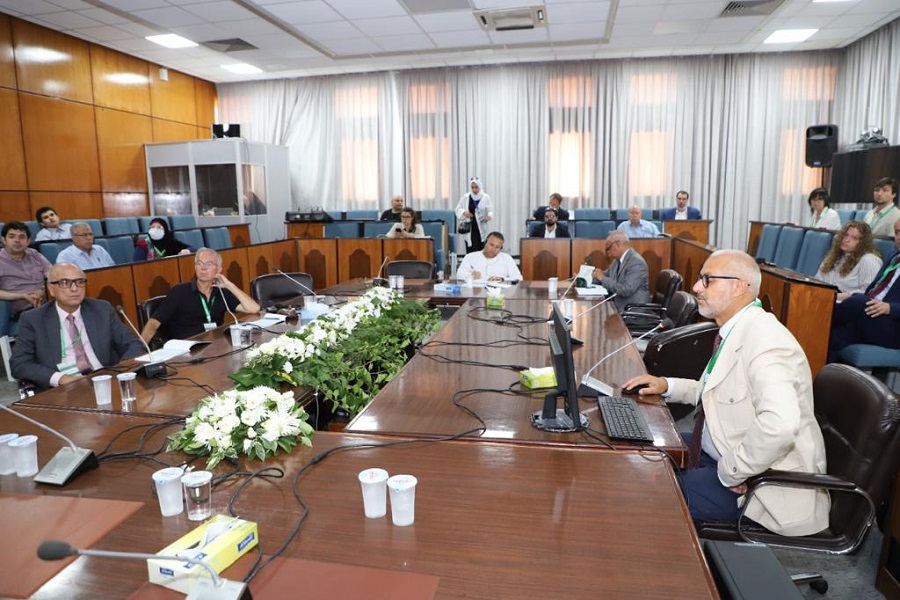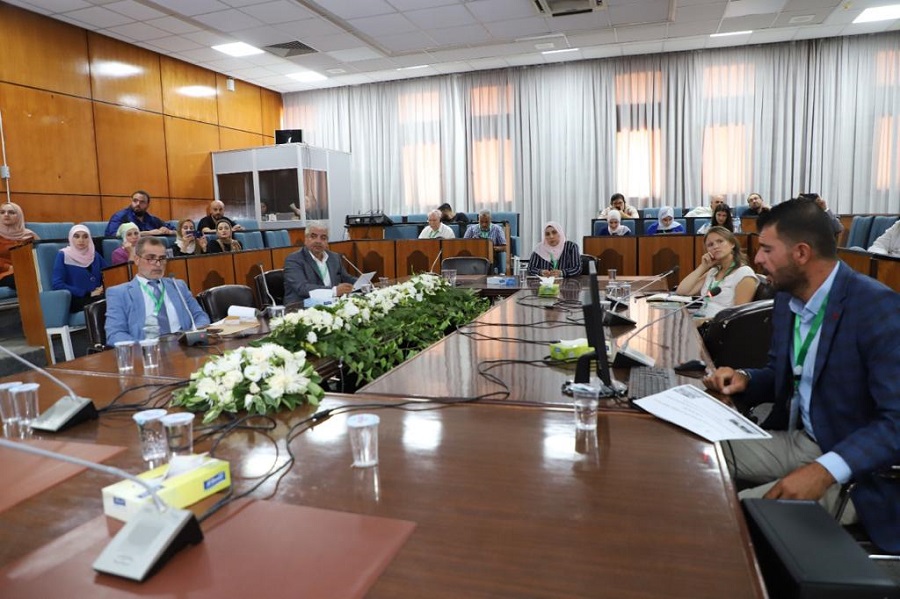
The 15th International Conference, "History and Archeology of Jordan", entitled "Thoughtful Archaeology in the Ecosphere and Sociosphere” continued its activities at Yarmouk University for the second day, including 12 scientific sessions tackling 13 different scientific themes where 57 in-person and 11 online scientific papers were presented. The first session, which was moderated by Dr. Mustafa Al-Naddaf and Dr. Abdullah Al-Shourman, included several papers, namely “on Pilgrimage to Mecca with the first Caliphs: The Umayyad Durub al-Hajj al-Shami across Jordan”, “Sustaining Good Practices in Jordanian Museum Education”, “Terraces as proxies for environment change”, “Tokens and Counters from EBA Jordan: A Case Study of Khirbet al-Batrawy”, and "the Concept of Civilization Crossroads for the Young Generation".
The second session, which was moderated by Dr. Talal Okasha and Dr. Claudia Buhrig, included: “Madaba Institute for Mosaic Art and Restoration and its Role in Promoting Cultural Heritage through Corona Pandemic”, “the Excavations of Umm Qais / Gadara 2005-2016 in Jordan”, “Wadi Sabra and its Theatre Reconsidered”, “Rome’s Legacy in Petra: New Data from Petra Downtown” and “Physical in Situ and Digital / Virtual Reconstructions and the International Heritage Charters and Conventions: A Critical Overview”.
The third session, which was moderated by Dr. Hani Hayajneh and Dr. Dominik Bonatz, included: "Water Sources for the Ancient Bedouins of Northern Arabia/Jordan Badia", "From Shamans to Priests: the Regional Role Played by the Neolithic in Jordan and the Idea of Religion", “The Palace of the Copper Axes at Batrawy: Architecture, Finds and International Relationships in the 3rd millennium BC”, “Salah Al-Din Al-Ayyubi Road between Damascus and Cairo Across Jordan - A Study in History and Archeology”, and “The Technical School of the Central Nabataeans Temples”.
The fourth session, which was moderated by Dr. Nizar Al-Adarbeh and Zeyad Ghnemat, included: “Evaluating Typologies of Churches at Umm Al-Jimal”, “Digital Library of Living Traditions - A Proposal for the Intangible Cultural Heritage in Jordan”, “Support to Livelihoods through Cultural Heritage Development”, “Curative Water in Jordan - Therapy, Tourism and Archeology”, and “Jordan Cultural Landscape, the Making of Significant Experience for the Museum of Folklore in Amman”.
The fifth session, which was moderated by Dr. Raed Al-Ghazawi and Dr. Abdullah Al-Rawashdeh, included: “The City of Jadara and its Human Heritage and Global Civilization”, “Conservation and Restoration of Organic Artifacts - Case Study of the Museum of the Lowest Place on Earth”, “Khirbat As-Sar, a Site between the Ammonite and Mamluk History of Jordan", "Funeral Rituals in the Southern Levant, A Comparative Study in Light of Archaeological Findings", "Flint Sources for Prehistoric Exploration and Use in the Contemporary Districts and Tafileh and Shawbak (south Jordan) as seen from a Geoarchaeological Perspective”.
The sixth session, which was moderated by Dr. Maher Tarbosh and Mohammad al-Shalaby, included: “Mamluk and Ottoman Mosques on the Shami Hajj Road in Jordan”, “Preserving the Past to Develop the Future: Rethinking Communities and Landscapes Relationships Starting from the Madaba Map”, “the Documentation of Amman Heritage Houses Using EAMENA Methodology”, “the First Results of the New Eastern Jarash Project”, and “Mapping for Tracking Networks of Skull Removal Mortuary Remains - An Analytical Approach of Chronological and Spatial Distributions to the Mortuary of Removed Skulls the Materials during the Neolithic Period”.
The seventh session, which was moderated by Dr. Lamia El-Khouri and Khaled Al-Tarawneh, included: “Maintenance and Restoration of a Lead Ark / Jerash (Applied Study)”, “the Conservation and Community Participation of Prince Alin Aq El Nasery Palace in Historic Cairo: Applications for Similar Sites in Jordan”, “Ain Ghazal Statue at Louvre Abu Dhabi: Exploring Stories of Cultural Connections”, “New Aspects of Social Life in the Hisma Region - Southern Jordan in the Light of Newly Discovered Ancient North Arabian Inscriptions” , “the Jaya Palace (Shobak). First Results of the excavations 2018 and 2021”.
The eighth session, which was moderated by Dr. Abdel Halim Al-Shiyab and Dr. Carol Palmer, included: “Historical Islamic Architecture in Northwestern Jordan - Heritage Mosques in Irbid Governorate”, “Education is the First Step of Protection before Archaeological Excavation: Khuraybit es-Sooq Site as a Challenging Example”, "Al-Hasa Castle in its Ecosphere and Sociosphere” ,"Approaching Islamic Archeology of Jordan: Projects, Opportunities and Challenges", and "Cultural Heritage and the Fight Against Illicit Trafficking in Jordan".
The ninth session, which was moderated by Dr. Pearce Paul and Dr. Alexander Ahrens, included: "Analyzing Cultural Heritage Trends in Higher Education at Jordanian Universities", "Cultural Globalization: Arabizi, Reality and Recommendations", "Rapid Tectonoc Evolution of the Levant during the Pleistocene and its implications to Topography and Local Lakes’ Formation and Disappearance - Factors Affecting Human Migration and Settlement”, “Capacity Building for Sustainable Preservation”, and “Unveiling the Memory of Amman: Retrieving the Roman Heritage of Al Hashimi Street as Part of Amman Urban Heritage”.
The tenth session, which was moderated by Dr. Lorenzo Nigro and Dr. Joseph Greene, included: "Ba’ja PPNB Site Jamila’s Grave CR36.1.44 from Gloomy Soil to Museum Lights", "3D Virtualization of the Roman Aqueduct of Gadara, the Ancient World’s Longest Water Aqueduct”, “Preliminary Report on the Excavation of the Lower Terrace of the Temple of Zeus (Gerasa/ Jerash) and “Southern Jordan in the Late Prehistory: New Data from Polish Archaeological Research Conducted in years 2019-2021”.
The eleventh session, which was moderated by Julie Bonneric and Leena Bakkar, included: "New Light on Transjordanian Cooking Ware from the Roman to the Umayyad Periods", "Valorization and Site Development at the Iron Age Site of Busayra”, "Architectural Analysis of Beit Ras Theater and its Connection with the City Walls", and "the Procedures for Rehabilitating of Ajloun Castle as an Archaeological Tourist Site in Light of International Standards and Development Requirements."
The last session, which was moderated by Aktham Alabbadi included: , “Result of Archeological Excavations at Tell Shiekh Isa Byzantine Church Astonishing Discoveries 2019”, and “a Sundial or Traditional Game - A Comparative Study.”
The activities of the second day included also launching an exhibition of posters on research projects in the fields of archeology, anthropology, restoration and maintenance of heritage sources, in addition to an exhibition for selling books in archeology specializations from the Department of Antiquities.








